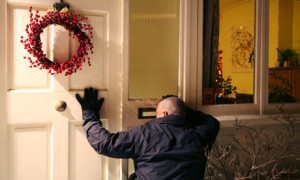 There are many factors that affect our risk of becoming victimized to the crime of burglary or larceny. The first factor is the weather. According to the Department of Justice’s Bureau of Justice Statistics and the Federal Bureau of Investigation, criminal activity has a strong positive correlation with temperature. As the temperature increases, so does criminal activity. The next influence to be aware of is the time of year. Criminal activity tends to increase during the holiday season. The weeks leading up to both Christmas and Hanukkah are particularly dangerous. During these holidays, potential criminals are aware of the abundance of presents and expensive objects people possess.
There are many factors that affect our risk of becoming victimized to the crime of burglary or larceny. The first factor is the weather. According to the Department of Justice’s Bureau of Justice Statistics and the Federal Bureau of Investigation, criminal activity has a strong positive correlation with temperature. As the temperature increases, so does criminal activity. The next influence to be aware of is the time of year. Criminal activity tends to increase during the holiday season. The weeks leading up to both Christmas and Hanukkah are particularly dangerous. During these holidays, potential criminals are aware of the abundance of presents and expensive objects people possess.
Police may decide to increase resources and time towards a particular area of a city due to an increase in illegal activity. Often, the areas surrounding the area of increased police and security guard attention are more susceptible to criminal activity than previously. This is a phenomenon known as spatial crime displacement, and it is especially common with the crimes of burglary and larceny. Whether you are trying to secure your residence, an organization, or an abandoned building; there are many useful tips to utilize which can help secure any location from possible offenders.
Tip #1 – Surveillance
Potential wrongdoers of burglary and larceny may conduct surveillance on a target location before attempting the criminal act. The buildings which are more likely to be victimized are those which have poor visibility from the public’s view. Additionally, if a business has their windows covered with advertisement/sale boards, then the interior of the business is less visible to the public eye and less secure.
The most effective deterrent for these structures is a private security guard. The presence of the private security officer is enough to deter criminal activity. Burglars and larceners avoid all confrontation if possible. A private security guard is also very cost-efficient, especially if the organization or place of residence has a negative history with victimization and has suffered a loss of assets or is in an area near where these offenses have been taking place more frequently.
Tip #2 – Occupancy
While conducting surveillance on a target location, criminals will carefully observe whether or not the structure is occupied. These criminals will document foot traffic at the structure. Once again, the mere presence of a uniformed security guard can deter such activity. The last thing a burglar or larcener wants is confrontation with somebody, especially a private security guard.
Not everybody is willing to hire a private security guard for their personal residences. It is important to make the potential offender perceive that there is somebody present in the dwelling. In order to do this, both interior and exterior lights should be set on a timer which will automatically program them to turn on when it is dark outside. It might be intelligent to set a television on a timer as well, to make it appear somebody is home.
Tip #3 – Accessibility
The final factor thieves consider is the accessibility of the desired goods. The more difficult a structure appears to enter; the less likely that structure will be chosen as the victim. Once again, a private security guard can control and monitor accessibility of a building while observing and reporting any suspicious activity. Ensure that doors and window are locked and that the building does not have a breach of security.
For a personal dwelling with no private security guard present, it is important to make the structure as difficult as possible to enter. Install dead-bolts, alarm systems, and security cameras with signs. All are good measures to protecting a structure from potential criminal activity.

